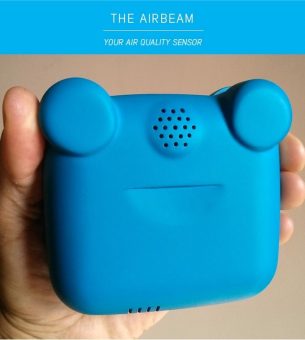
Last summer, about a dozen high school and college students fanned out across the South Bronx and Brooklyn into four neighborhoods heavily trafficked by waste-hauling trucks. They counted the trucks and used special wearable monitors to test air quality. Not surprisingly, the more trucks, the dirtier the air.
“These are communities that bear the brunt of manufacturing and industry and waste handling,” said Michael Heimbinder, executive director of Habitatmap, which works with community organizations and schools to promote public health. “Poor communities of color get all the environmental burdens and none of the amenities, like parks, recreation centers — and clean air.”
The young people were gathering data for a report on waste zoning policies. They represent a growing number of citizen scientists all over the world who are using new technology to improve the quality of life in their own communities.
In this case, the new technology is an instrument called the AirBeam. The device was designed, programmed and tested by high school STEM students in Queens. It’s manufactured and sold by Habitatmap.
The monitor measures fine particulate matter, which can be dangerous for human health. Particles can travel deep into the respiratory tract, causing short-term health effects — irritation to the eyes, nose and throat, coughing and sneezing — as well as long-term damage to lungs, worsening conditions such as asthma and heart disease.
One study estimated that, in New York, chronic exposure from on-road vehicle emissions contributes to 260 deaths from respiratory and cardiovascular disease, and 720 emergency room visits and hospital admissions each year. Among these, fumes from buses and trucks account for the largest share of the city-wide burden.
Cutting pollution, even a little bit “can reduce the number of hospitalizations by hundreds and the number of deaths by dozens,” Heimbinder said.
The AirBeam device works by sending air through a chamber where light from an LED bulb scatters off particles in the air stream. This light scatter is registered by a detector. Those data are used to estimate the number of particles in the air.
The measurements are sent via Bluetooth to a smartphone app, which maps and graphs the data in real time. When the monitoring session is over, the data are sent to Habitatmap’s AirCasting website, where the information is combined with data from other AirBeam users. This information is used to generate heat maps showing where pollution is most severe.
In the last three years, Habitatmap has sold 1,500 AirBeams (at $249 each) to regulatory agencies, community organizations and academic groups all over the world.
Earlier this month, the Global Climate and Health Alliance launched a global initiative to fight for cleaner air in ten cities around the world. They are using AirBeams but have added one additional feature: an LED light mask that changes into one of four colors in real time — green (good air quality), yellow (moderate risk), orange (unhealthy for sensitive groups) and red (unhealthy for everyone).
Citizen scientists in India have been testing air quality since 2012, although they have been using a different device. In Ennore, Community Environmental Monitoring (CEM), a project of The Other Media, has been sampling various toxic hotspots to measure harmful metal pollution in dust.
“We see the value of low-cost air monitoring devices, like the AirBeam, especially in the Indian context, where there is hardly any data on air pollution in the public,” said Shweta Narayan, CEM’s coordinator. “The regulatory agencies in charge of generating and disseminating the data have failed to do that task. They often use a lack of data as an excuse not to take action on erring industries or the polluters.”
Low-cost monitors like the AirBeam enable pollution-impacted communities “to generate their own data based on their experience of — and knowledge of — pollution in their vicinity,” she added. “It empowers the communities with technical information, often the missing piece in fighting pollution, and assists them in holding regulatory agencies and polluters accountable.”
This certainly proved true of the New York City findings. There, students counted as many as 304 trucks per hour at intersections in the South Bronx, and measured particulate concentrations up to seven times higher than those tallied by the nearest state Department of Environmental Conservation monitoring station, according to the report. North Brooklyn saw up to 203 trucks per hour on weekdays, about a third of them commercial waste trucks.
Their report highlighted the inequities in heavily industrialized, low-income communities whose residents often suffer health disparities compared to other neighborhoods.
In response to the report, the city plans to divide the city into zones, allowing commercial hauling companies to bid for service contracts, rather than requiring private companies to hire their own waste-hauling services. A city study found that commercial hauling vehicles would travel around half as many miles total, because they would be working locally.
“The city has committed to doing it as a result of these groups doing what they did,” Heimbinder said.
Source: cleantechnica.com



